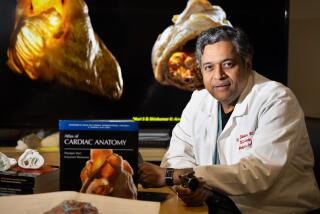Brazil Photos Support Identification of Mengele : 24 Key Facial Points Resemble Nazi’s, Experts Report; Inquiry Nears End
SAO PAULO, Brazil — A technical comparison of photographs has produced important new evidence that a man who lived clandestinely in Brazil was fugitive Nazi war criminal Josef Mengele, Sao Paulo Police Chief Romeu Tuma said Thursday.
Tuma also said that scientists are reaching the end of a painstaking examination of a skeleton to determine whether it is Mengele’s--as police believe. He said that a positive identification is likely and that final results may be announced as early as today.
The skeleton under examination was exhumed from the cemetery of Embu, a town near Sao Paulo, on June 6.
Brazil’s federal police have gathered what they consider to be convincing testimony and other evidence that the bones are those of Mengele, known as the “Angel of Death.” He is held responsible for the deaths of 300,000 to 400,000 prisoners, mostly Jews, at Adolf Hitler’s Auschwitz concentration camp. They believe that Mengele lived in Brazil starting in 1962 or earlier, that he died while swimming at a Brazilian beach in 1979 and that his body was buried under a false name, Wolfgang Gerhard.
Photographs Compared
But lacking ironclad confirmation, such as Mengele X-rays to match up with the skeleton, police are seeking every possible bit of scientific evidence.
Brazilian and West German experts compared three authenticated Mengele photographs with six photos of the man thought to have been Mengele in Brazil. Using what Tuma called “highly efficient methods” developed in West Germany, they found coincidences in 24 key points of facial anatomy shown by the two sets of photos.
The report of the photo study, issued at a Thursday press conference by Tuma, concluded “with a high degree of probability” that the man photographed in Brazil was Mengele.
Showing reporters copies of the photos, sprinkled with small arrows and numbers in red ink, Tuma said that the study was “another very important detail” in the Mengele investigation.
Earlier, Tuma said that the police part of the Mengele investigation is all but finished.
“All of the testimony is in agreement,” he told reporters Wednesday in his daily press briefing. “There are no divergences.”
He said that Brazilian, West German and American experts are working long hours in an effort to finish the scientific study of the skeleton.
“Everything is pointing toward a positive identification,” he said.
Painstaking Process
Examination of the skeleton is a painstaking process of investigation by committee, with seven Americans and three West Germans participating alongside Brazilian scientists.
Authorities want full agreement among the foreign and Brazilian experts to bolster the credibility of whatever conclusion is ultimately reached.
“They are trying to come to a consensus on each point as they go along,” one official said. “This takes time.”
Four West German investigators, here to follow the investigation, are “99% sure” that the skeleton exhumed at Embu is Mengele’s, a German consular official said this week. American experts have said that handwriting samples recovered from an Austrian-born couple, who admitted protecting Mengele here, were penned by the infamous death-camp doctor.
The couple, Wolfram and Liselotte Bossert, have testified in depositions that Mengele died as a result of an apparent stroke while swimming at Bertioga beach on Feb. 6, 1979. Chief Tuma, however acknowledged that final scientific proof of Mengele’s death is still lacking.
No Clear Fingerprints
The Brazilians have found no clear fingerprints of the man who lived in Brazil to compare with certified Mengele prints. They have received no medical or dental X-rays of Mengele--or the man believed to have been Mengele--to compare with bones and teeth from the Embu grave.
To compensate for the lack of such key elements, scientific investigators are trying to build up “an accumulation of proof” to positively identify the skeleton, Tuma said. He added that the results of the police investigation will be more credible to the world if they are backed by evidence from a thorough scientific investigation, endorsed by foreign specialists.
The Brazilian and foreign scientists are conducting microscopic studies of thin slices of the pelvic and femur bones taken from the grave at Embu to determine as precisely as possible the age of the dead man. And they are looking for signs of a pelvic injury that Mengele was said to have suffered in a motorcycle accident during World War II.
They are analyzing hair from the grave for indications of blood type and age. They are comparing that hair with hair strands found among belongings of the man thought to be Mengele.
So far, the scientists have announced preliminary findings that the height, sex, race and approximate age of the skeleton coincide with those of Mengele.
“Nothing has come up to definitively rule out the possibilities that the bones are Mengele’s,” said Daniel Munoz, the chief of forensic medicine at the Sao Paulo state morgue.
‘No Definitive Conclusions’
Munoz and other experts, however, refuse to give details of information that they have developed so far. “There are no definitive conclusions,” Munoz said. “There is progress, but nothing that could be called 100%.”
As different stages of the examination produced results, Munoz said, “each group of investigators is checking those partial results.”
Three of the U.S. investigators were sent to Sao Paulo by the U.S. Department of Justice. They are Ellis Kerley, a forensic anthropologist with the University of Maryland; Dr. Ali Hameli, Delaware’s chief state medical examiner, and Dr. Lowell Levine, an odontologist from the New York University School of Dentistry.
Also taking part are four experts sponsored by the Los Angeles-based Simon Wiesenthal Center for Holocaust Studies. They are Clyde Snow, a forensic anthropologist from the University of Oklahoma; Eric Stover of the American Assn. for the Advancement of Science; Dr. Leslie Lukash, chief medical examiner for Nassau County, N.Y., and Dr. John Fitzpatrick, chief medical examiner of Cook County, Ill.
Americans Decline Comment
The U.S. participants in the scientific investigation have declined to comment on its progress.
More to Read
Sign up for Essential California
The most important California stories and recommendations in your inbox every morning.
You may occasionally receive promotional content from the Los Angeles Times.










